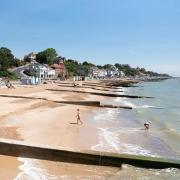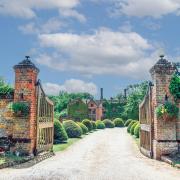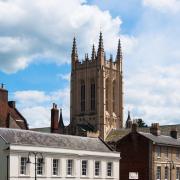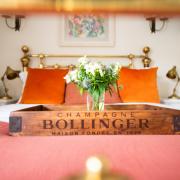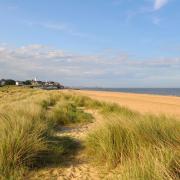A butcher, a baker, a former clockmaker; mountains of fruit and veg on market day; cafés and confectioners brimming with carefully crafted sweet-treats, and a smartly restyled coaching inn full of friendly faces and delightful field-to-fork dishes . . . Saxmundham has all the mouth-watering ingredients you’d expect from a Garden of Suffolk market town.
Take a stroll around ‘Sax’ with fresh eyes open and you’ll soon spot the signs of its salad days. From Dutch gables to Doric columns and decorative Art Nouveau detailing, its historic streets have a feast of clues pointing to its local rich pickings and trading prowess of the past.
These days the fine market hall is more used to welcoming concert-goers than seeing money change hands for cartloads of corn, and successful supermarkets have taken root where the livestock auctions used to be, beneath the church’s ancient hilltop site by the forgotten River Fromus. Herdsmen would ‘lay up’ their stock before the market on Saxmundham’s southerly valley slopes known as ‘The Layers’, where the Suffolk Show’s flourishing Victorian forerunner was held 14 times.

Artist TW Cotman’s mock-Jacobean manor house stretches out across the flood plain opposite, while houses now occupy Brook Farm’s northerly dairylands and the doctor’s waiting room has taken the place of pens on Lamb Sale Meadow. But Sax still has some great grazing grounds - just check out the High Street’s inviting galleries and interiors stores, its studios, time-honoured stationers, or events at Art Station in the former telephone exchange.

From Easter to autumn, the town’s fab, free museum lays out history aplenty, sharing local interest films in its playhouse cinema room, and all the trappings of bygone shops and trades in its walk-through replica street scene. But nothing beats getting out and about to put things in perspective and make the connection - and it’s Saxmundham’s connections throughout history, whether by river, turnpike road or rail which lie at the very heart of its success story. Wuth its North and South Entrances, this gateway to East Suffolk and the coast made going places its business and has been delivering the goods for centuries. Why not savour just a few of its stories?
A Tale of Two Rivers
Evidence suggests that Sax’s tiny River Fromus was once navigable and early finds point to early Bronze Age (1500 BC), Iron Age, Roman and Saxon activities alongside it. The town’s name might even translate to ‘Saxon Hill Settlement‘. For generations there’s been easy access from Sax to the River Alde, four miles away. Poorly paid, seasonal farm labourers often walked to Snape Port, or via the Sailors’ Path to Aldeburgh, to become ‘Greenhands’, doubling up as fishermen or crew on river barges which moved malt, grain or livestock to London, returning laden with animal waste to fertilise Suffolk’s fields.

Other folk found the coast conveniently close for keeping starvation at bay by smuggling tea and tobacco. In the 1740s, they had to take care though – the landlord of Sax's Bell Hotel was also an excise officer.
A well-connected town
It’s only since the 1988 bypass that Sax has been ‘off the beaten track’. Today, we can’t imagine A12 traffic snaking its way along the narrow High Street, past the small stretch of serpentine wall at the back of tiny, historic Angel Yard.

By North Entrance, little Tollgate Cottage suggests the spot to settle market dues or turnpike tolls. With Sax firmly on the new 1785 Ipswich to London road route and, by 1792, the link point for Aldeburgh, no wonder the market town was a natural hub when railways transformed business and the fledgling resorts on the coast.
Home to industrial giants
Saxmundham benefitted handsomely from the enterprise of the eminent Victorian industrialist Richard Garrett III, who had the original Carlton Hall and Park just beyond the town’s North Entrance as his country residence.

Garrett transformed his family’s successful agricultural engineering and steam engine business by building the UK’s first ever assembly line at the Long Shop in Leiston. The railway lines he helped to secure for his works, for Snape Maltings and Aldeburgh ensured that Sax didn’t just handle all the Long Shop’s phenomenal output, until well after the Second World War, but all the Maltings-bound barley and the coast’s developing visitor traffic too.

Buried in Carlton churchyard, Garrett is remembered in Leiston’s parish church by a bust crafted by the fine Saxmundham sculptor, Thomas Thurlow (1813-1899). Today, part of Carlton Park is a sports ground and play area, graced with the work of a contemporary sculptor from the Sax area, Paul Richardson.
Did you know?
Saxmundham celebrated the 750th anniversary of its 1272 market charter last year. By 1336, the town was known as ‘Saxmundham Market’. Although Sax held its last livestock sale in 1977, market stalls still grace the original marketplace today (on Wednesdays), as well as the newly created Fromus Square.
Near South Entrance is the recently refurbished ‘Jacobean’ Hurts Hall, the second hall styled here by the Long family since acquiring the Manor of Hurts in 1650. The Longs supported Sax’s turnpike road, paid for a school, Market Hall, church windows and the Garrett-made town pump. Their family memorials reside in the parish church. Hurts Hall’s finest hour was perhaps during the Second World War, when it hosted a D-Day planning meeting attended by Winston Churchill, Eisenhower and Montgomery.

Saxmundham’s ‘Layers’ have hosted some interesting folk in their time, including a group of Russian Cossacks who entertained Suffolk Show guests with daring riding displays, and The 6th Cyclist Battalion of the Suffolk Regiment, who spun bravely off from their camp to help at Theberton’s German Zeppelin crash in 1917.
The Bell was in full swing, although not the grand coaching inn we know today, when King George II stopped off and put Sax on the map in 1732. However, how many folk know of the late Duke of Edinburgh’s frequent visits as a lad to stay with chums at The Beeches near North Entrance. The late Queen Elizabeth II and Princess Margaret enjoyed regular stays with friends at Sternfield House just outside the market town.
Tall stories
Once measuring 15.5 metres high, Sax’s Albion post-mill was one of the tallest in Suffolk. Its base still survives today, converted into a stylish circular home.
Almost within living memory, Market Place confectioner, fruiterer and stilt-walker Alfie Proudfoot would put his stilts on to entertain at celebrations by climbing out of his first floor window.
Find out more
Check out The Pocket Guide to Saxmundham, a handy, free, fold-out publication packed with information, directed walks, including a Saxmundham ‘Town and Country’ heritage stroll and Kelsale-cum-Carlton ‘Landmarks & Legacies’ walk, plus ideas for cycle rides and outings, produced in association with East Suffolk Council. Available at Saxmundham’s shops/cafés, library and town council offices or download at thesuffolkcoast.co.uk




